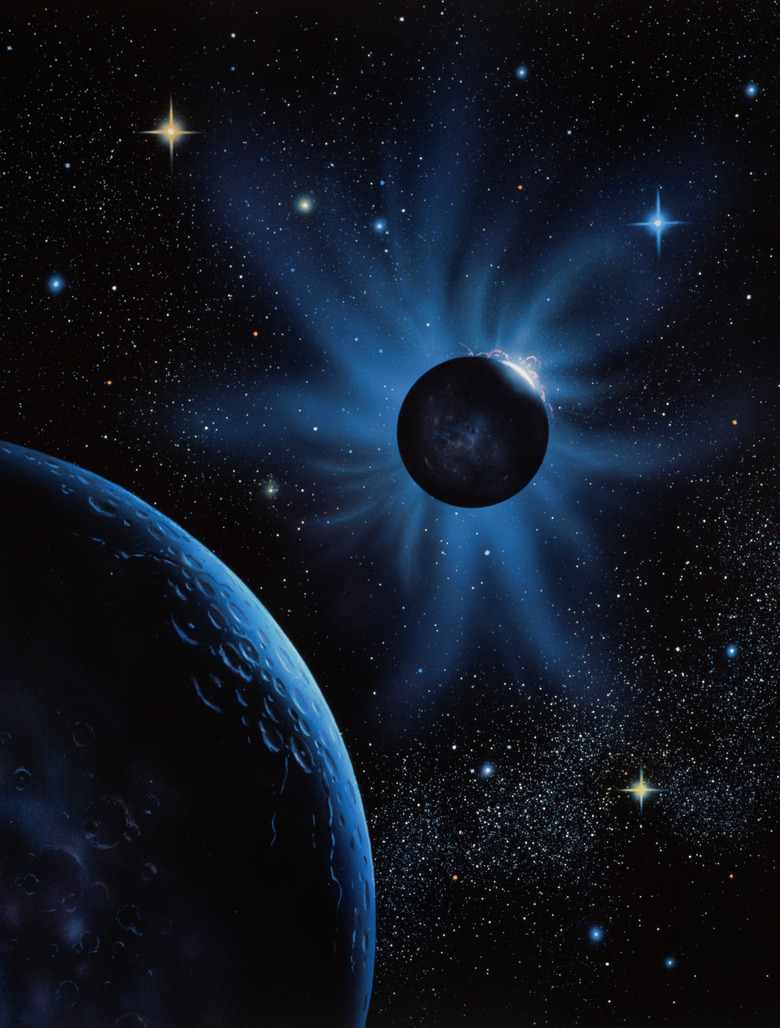What Is The Darkest Portion Of The Moon's Shadow During A Solar Eclipse?
Only a small percentage of humanity observes the sun disappearing behind the moon's shadow during a total solar eclipse. This is because the moon's umbra, the darkest portion of its shadow, follows an extremely long but narrow path over Earth's surface. As the moon passes the sun, the umbra quickly travels eastward, so the lucky few observers have only a few minutes to observe the total eclipse.
Solar Eclipse Basics
Solar Eclipse Basics
A solar eclipse is only possible during new moon, when the moon is on the same side of the earth as the sun. An eclipse doesn't happen every new moon, however, because the moon's orbit is tilted relative to the ecliptic — the plane of earth's orbit around the sun. The new moon must be crossing the ecliptic, or at least be very close to it. When this happens, its shadow, or umbra, intersects Earth, and darkness descends on those places inside it. People just outside the umbra are in the penumbra, and will see a partial eclipse.
Annular Eclipses
Annular Eclipses
One other condition must be satisfied for observers on Earth to witness a total solar eclipse. The moon must be close enough. Because of its elliptical orbit, the moon's distance from the earth varies, and when it is at its farthest, its apparent size is too small to block the sun. The entire disk of the moon is visible across the sun's face during an annular eclipse, but there remains a thick band of sunlight around its perimeter. There is no umbra on Earth during an annular eclipse. Observers in the antumbra, which is the partially-illuminated umbra produced during this type of eclipse, see a kind of ghostly twilight instead of night-like darkness.
The Size of the Umbra
The Size of the Umbra
Solar eclipses are so spectacular on Earth because the apparent sizes of the moon and sun are the same. This is a happy coincidence — the sun is 400 times larger than the moon and just happens to be 400 times farther away. Because the sun is so much larger than the moon, however, the moon's shadow appears much smaller on Earth that the moon itself. That's because sunlight is impinging at an angle from the much larger disk of the sun. The umbra forms a cone that narrows to a width of 100 miles by the time it reaches Earth.
The Movement of the Umbra
The Movement of the Umbra
During a solar eclipse, the umbra or antumbra travels eastward at a speed of nearly 1,100 mph, which is the difference of the orbital speed of the moon and the rotational speed of the earth. This path is typically about 10,000 miles long, and not everyone along it sees the same thing. In particular, during a hybrid eclipse, some people may observe totality while others observe an annular eclipse. This phenomenon is caused by the curvature of the earth, and can only happen when the moon is at just the right distance from the earth for it to make a difference.
Cite This Article
MLA
Deziel, Chris. "What Is The Darkest Portion Of The Moon's Shadow During A Solar Eclipse?" sciencing.com, https://www.sciencing.com/darkest-portion-moons-shadow-during-solar-eclipse-3210/. 24 April 2017.
APA
Deziel, Chris. (2017, April 24). What Is The Darkest Portion Of The Moon's Shadow During A Solar Eclipse?. sciencing.com. Retrieved from https://www.sciencing.com/darkest-portion-moons-shadow-during-solar-eclipse-3210/
Chicago
Deziel, Chris. What Is The Darkest Portion Of The Moon's Shadow During A Solar Eclipse? last modified March 24, 2022. https://www.sciencing.com/darkest-portion-moons-shadow-during-solar-eclipse-3210/
